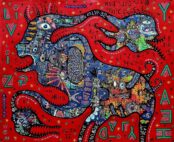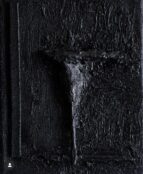“My paintings are often large diptychs, or a number of canvasses, made without preliminary sketches or any other devices,just using my eyes and a pencil, drawing straight onto the bare canvas. Working on bare canvas means that whatever I paint remains. This gives the process of painting an element of risk—a kind of performance in the making of it. Although areas of my paintings are rendered in great detail I allow unpainted areas to allow space and give the viewer room to form a discourse with the image.” Artist statement, Martha Parsey
The large canvasses of Martha Parsey contain stylised worlds, where action, geometry and perspective create a colourful dissonance. The figures in her paintings, playing out stylised narratives, encourage an emotional and symbolic reading as they intersect a network of unconscious elements.
Over the course of her career Parsey’s figures have shown a range of poise and tone from violent to subtle, drawing a parallel between cardinal emotion and surreal geometry. A signature element in her work is the manner in which objects and figures emerge and disappear into unpainted areas of canvas;painted areas in Parsey’s work signify static consciousness, whereas the blank spaces are areas where potent imagination is left to play with historicity. What is unsaid here? What details are omitted and why?
With the artist living and working in Cologne and London, Parsey’s paintings are part of a number of prestigious collections worldwide including the Ovitz Family Collection, the Zabludowicz Collection and the Musée National d’art Moderne, Paris. In this issue of Trebuchet, Parsey describes the physical process of painting as well as the process through which she ascribes the body as figure and position in her work.
How do you define the body?
The body is often not fully defined as a solid space in my work, sometimes only by markers: clothing, jewellery, buttons or the shape of the silhouette. In fact a lot of the time the body consists only of the bare canvas, which has a skin-tone texture to it.
In what way do you feel you’ve pushed your conception and application of the body?
I think I’ve stretched the idea of what needs to be defined and what doesn’t.
Read this article in full in Trebuchet 4 – The Body

The aim of art is to represent not the outward appearance of things, but their inward significance. – Aristotle


















